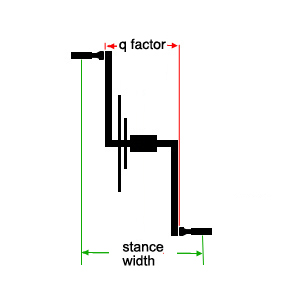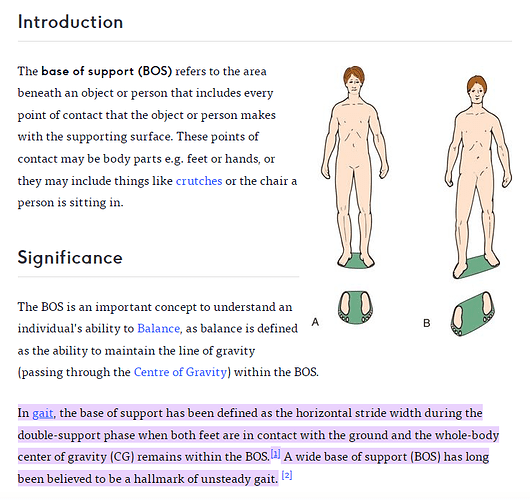That seems pretty reasonable - my bike right now has 309mm BB height (FS, unsagged, 120mm fork), and with 165mm cranks I don’t have trouble anywhere except the really nasty technical climbs. tbh I don’t think a few extra mm would help. Give it a go, see how it rides!
I typically design for 300mm BB height at sag with 170mm cranks unless the customer prefers higher cranks for rocky tech. IMO, the lower the better.
I rode my hardtail in Sedona with this setup and it worked well except for the trials type moves that I suck at anyway so I’d probably be walking those sections regardless.
Walt, Definitely agree on not being weird enough! Thanks for all the crank length contributions here, very nice to read.
Perhaps you’ve seen, I’m latched on pretty heavy to the crank length life here.
I’m 6’2" and rode 155’s for years helped my knees. Know I’m living life on 145’s and really enjoy the more open hip.
Now that you guys have discussed pedaling and efficiency ad-nauseum, I think it is time I step in with my skills instructor badge and remind everyone of the other half of cycling: Not pedaling.
I have actually given this a lot of thought over the last few years, how crank length affects rider stability and cornering technique. So far I have come up with two arguments to show that you can go TOO short:
Many people will invoke dirt bikes when discussing short crank lengths, since they have an effective crank length of zero when standing on the pegs. I haven’t ridden dirt bikes much but I know technical descents are not the easiest and I have a theory.
- Proper descending is done on your feet, your hands are just there to keep you upright and control the bar. Legs are your built in suspension and the strongest muscles in your body. From a physiological standpoint, when in the classic ready position (pedals level), reducing crank length will effectively shorten the rider’s Base of Support (BOS)
(Pardon the nudity, this particular example refers to gait which does not correlate to this discussion but is a great representation of BOS.)
As you can see, smaller your BOS (shorter crank length, closer feet), the less stable you become due to decreasing leverage. The smaller your BOS, the more likely your CG will leave the BOS. This creates an unstable system which necessitates shifting weight to your hands, possibly at times you don’t want it there.
When riding dirt bikes, there are other contact points (fuel tank and seat) for your legs that you can use to increase your stability but this does not work on mtb unless you are in a turn.
This can be shown through a simple experiment:
On solid ground, place your feet in the same position they would be in with an effective crank length of 0. The only distance between them is representative of your Q factor. Now assume a ready position (deep crouch, feet weighted evenly, hands on imaginary handlebars), lean forward as far as possible before losing balance, now lean backward as far as possible before losing balance. You will feel quite unstable when you do this.
Next, Place your feet in the same position they would be while riding a standard bike with an effective crank length of 165. Now assume a ready position (deep crouch, feet weighted evenly, hands on imaginary handlebars), lean forward as far as possible before losing balance, now lean backward as far as possible before losing balance.
Which one feels more stable and powerful to you?
This is not me saying that cranks are currently the correct length or that there is a correct length, but I think it is a good exercise to remind us that engineering is a balance act (pun intended) and there is a very real effect on riding dynamics when shortening cranks. I have more to say on the issue but I’ll save it for my blog ![]()
But is this destabilization a bad thing? How often are you going in a straight line when standing and coasting?
Freestyle bmx and DH have both been trending towards shorter cranks for a long time. You can get 155mm cranks for either sport from ‘normal’ brands and shorter ones from more niche brands.
Shorter cranks allow to corner (and spin) faster and harder - especially in your non dominant direction. The more separated your feet are with long cranks the more your hips are only opened up to cornering in one direction. You body is essentially ‘coiled’ to only corner one way efficiently, and shorter cranks help mitigate this.
You can test this in the same ready position by pointing your hips / belly button through imaginary corners.
If you want a visual representation of how this effects your riding, look at the cornering lugs on your rear tire - the dominant cornering side will be more under cut from cornering fast / harder. (This is most obvious on soft compound tires)
I completely agree that destabilization is not necessarily a bad thing. Crank length mostly affects destabilization in the fore/aft direction IMO which isn’t generally what you would want when riding technical terrain.
But you are touching on my next point which is that everyone has a dominant forward foot which usually translates into a favored turning direction. I think this is directly related to foot position because in my experience, one direction: turning toward your forward foot, you can “turn harder” because your “top” foot in the turn is much closer to the rear axle, allowing you to instantaneously change your FC/RC ratio and really whip the front of the bike around.
If you look at the other direction: turning towards the rear foot, you will find the opposite effect once the bike is leaned into a turn. Some riders will go so far as to switch forward foot in anticipation of turn direction.
I need to sketch to few of the force charts in my head to better illustrate.
I also agree with what you are saying about hip mobility and that touches on the other half of the equation: If moving feet too close together (shorter cranks) negatively affects balance, then moving cranks too far apart (longer cranks) negatively affects total range of motion.
So I think there is a sweet spot for each rider in this regard as well as when pedaling dynamics come into play, my question is how do the two interact? It would make intuitive sense that optimizing crank length around one or the other (pedaling or handling) would actually optimize both since both depend on range of motion for a given persons legs.
Basically, I need to get lone short cranks to nerd out with!
Sorry, it’s time for me to bail on the forum.
Sorry, it’s time for me to bail on the forum.
Interesting points all around. It seems like in general when descending straight down steep terrain, you would need to raise the handlebars and reduce reach to get the same support feeling as cranks get shorter.
The BOS is a good theory. I find that good riders use their legs and core to ride, so anything that gives you more leverage to control your center of mass makes it easier.
I think a similar analogy can be for wide vs narrow handlebars (whatever “wide” means for an individual’s morphology).
I know one person who is 5’8 but swears by 800mm bars. They have so much leverage and stability that they don’t get de-stabilized through rough terrain. On the flip side, they can only straight-line everything because they are locked into a static position ![]()
Another analogy is pedal stance width:

I realized for endurance riding (road and mtb) I prefer a narrower stance for ergonomics. But for more technical riding with slacker headtube angles, I like a wider stance so its easier to lean the bike with my legs and core.
To help facilitate this discussion between different theories, it’s important to keep in mind that people have totally different levels of fitness, riding abilities, and riding styles.
A pro downhill racer probably has amazing strength, balance, mobility, and sensitivity to feel their center of mass relative to the contact patches.
The average rider rides very statically in a fixed body position and relies on the cranks and handlebars to provide stability.
I also don’t understand why the diagram needed to be nude ![]()
BOS comes into play very often with mountain biking since it is entirely a balance sport. I talk a lot about BOS of the entire bike, rider system a lot in my more advanced classes:
- The tire contact patches are the BOS
- The Center of Gravity of the entire system is used.
- This is a great illustration of why we (all riders) lean backwards on descents and forward on climbs.
- The BOS actually shrinks with attitude changes due to the direction of gravity (also a theory) being constant (normal to the center of the earth).
- “If your CG leaves your BOS, You’re gonna have a bad time” - Brock
This is my favorite way to look at wheelbase and shows why a longer wheelbase is more stable on descents.
This is also why I am a strong believer that bikes have gone from too small to too large in a span of 5 years. I recently downsized my size large Ripmo (475mm reach) for a size medium Lithium (450mm reach) and can feel the improvements when cornering and moving dynamically. The reasoning for this is because:
- As BOS is reduced, the same amount of rider input will move the system CG further in relation to the BOS than if the BOS was larger.
This translates to less work and quicker reaction times for the rider system, with the trade off being a less stable system and necessitating finer precision of rider input. But dam can you slap a corner!
I was going share my ideas on how crank length affects cornering but I can already that y’all aren’t ready for that so you can catch it on my blog.
I implore you to post anyways. It’s important to keep in mind the experience that some of these posters have. Walt has been building forever, and even if you don’t agree with him (or find him a bit harsh), there can still be truth in what he says. Just like there is truth in what you’re saying. I know I’ve run into that on this forum, and it can sting. But at the end of the day, if it stings, maybe there is a hole in your methodology you haven’t thought of or considered. Obviously, this goes both ways.
Its also easy to forget that bicycles have so many variables, and that something as small as tire pressure or bar width can change many things. I know this thread is getting into nitty gritty, but if I’ve learned anything from this forum, it’s that sweating the small things that are just generally talked about anecdotally will give you a headache.
It can be hard to receive negative feedback about something you feel well versed in and have researched. Imagine how peer reviewed researchers feel when they receive negative feedback or hard questions.
I don’t have a horse in this race, but it seems the very tiny length differences between common crank sizes wouldn’t have a noticeable impact on BOS.
I mean sure the difference between 0mm crank arms and 200mm crank arms would be noticeable. But if I went from my normal 170mm cranks to 165s, I doubt I’d notice it.
